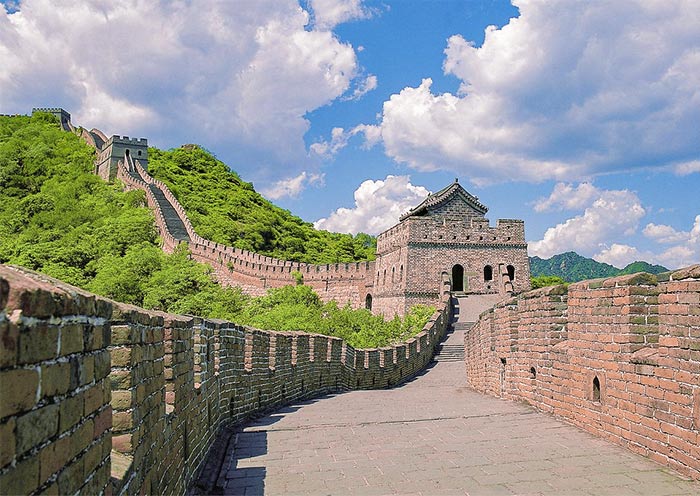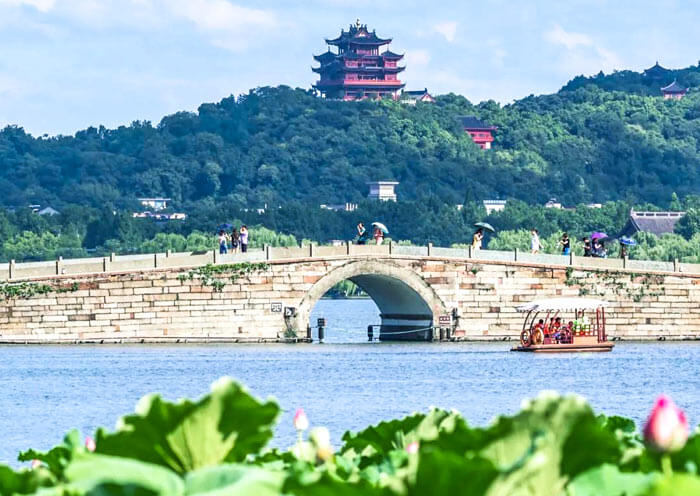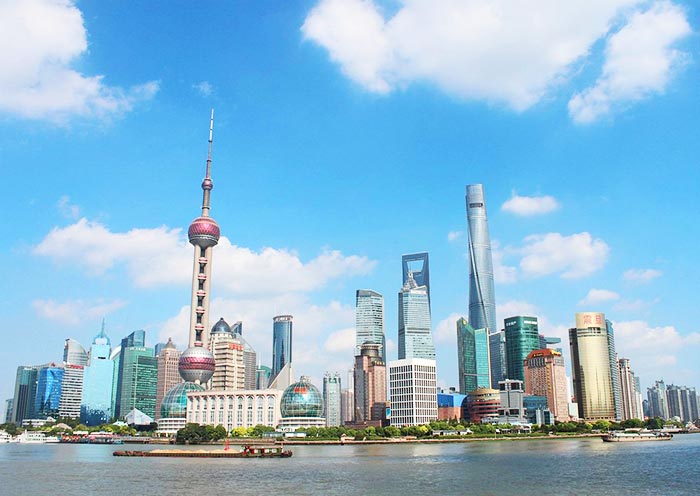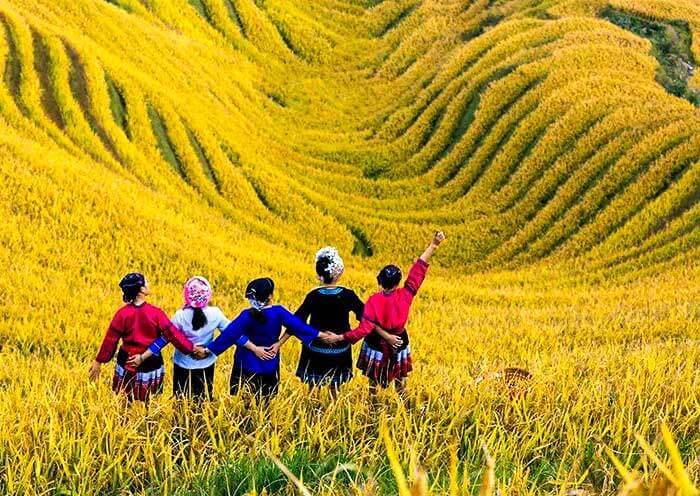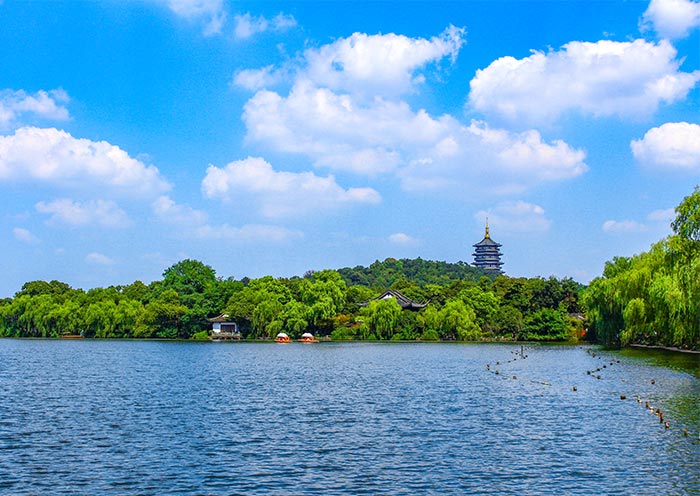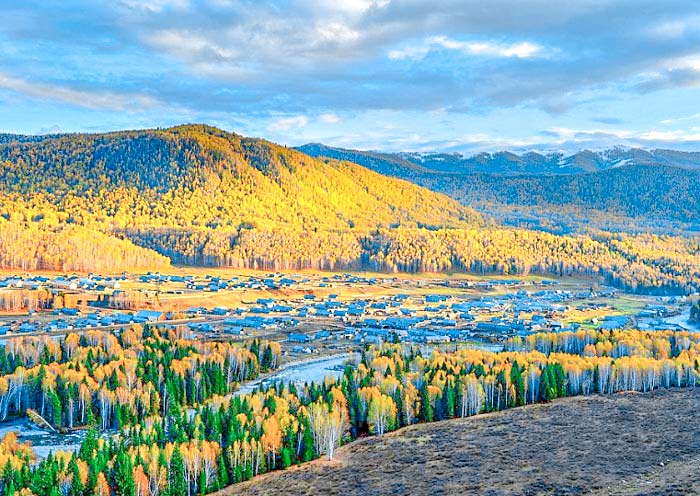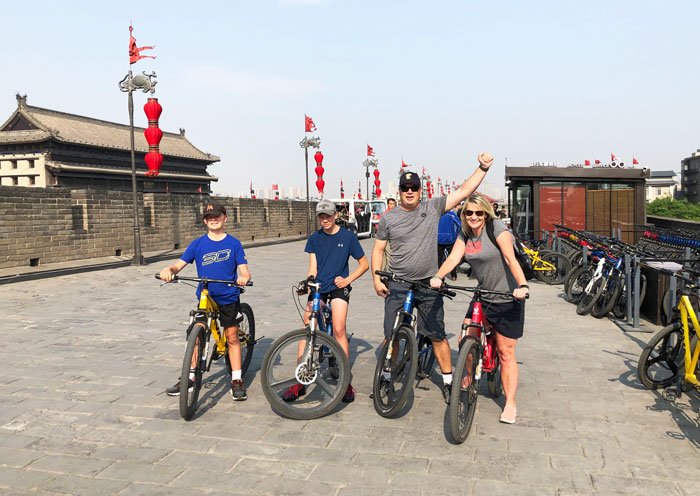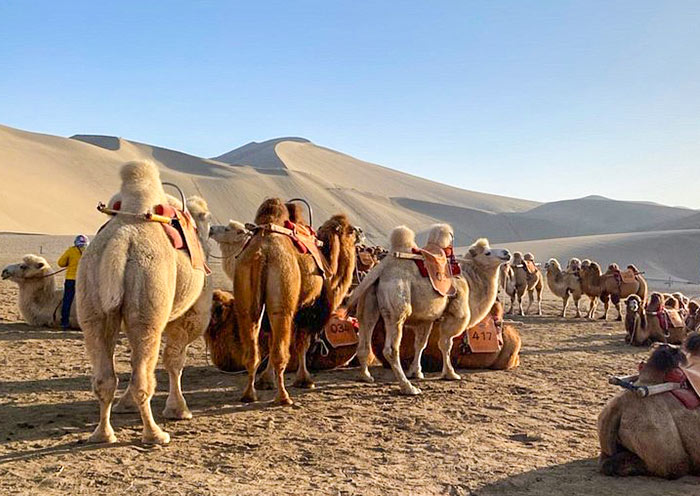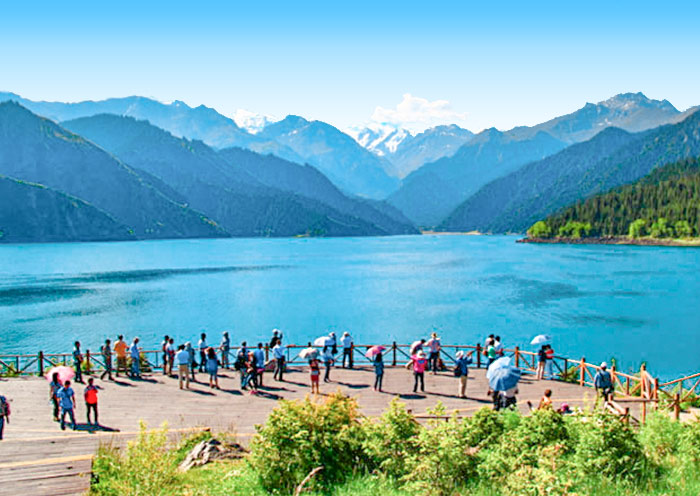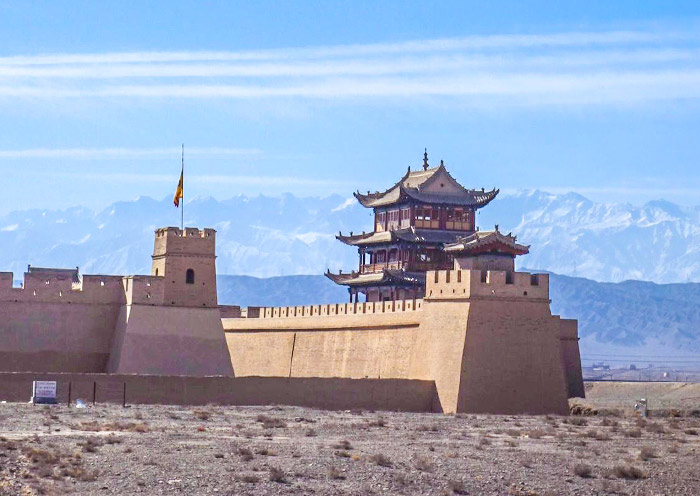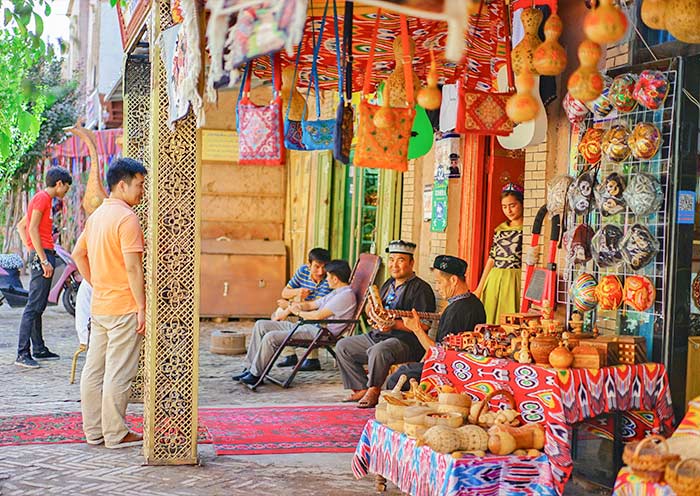| Grottoes | History | Location | Number of Caves | Significant Features | Accessibility |
|---|---|---|---|---|---|
| Mogao Caves | 4th century AD | Dunhuang, Gansu | 492 | Extensive Buddhist art | Train/flight to Dunhuang |
| Yungang Grottoes | Northern Wei Dynasty | Datong, Shanxi | 53 | Majestic statues | Train/bus to Datong |
| Longmen Grottoes | From late 5th century | Luoyang, Henan | 2,300+ | Iconic sculptures | Train/bus to Luoyang |
| Maijishan Grottoes | From Northern Liang Dynasty | Tianshui, Gansu | 194 | Tibetan-style carvings | Train/bus to Tianshui |
| Bingling Temple Grottoes | Western Qin Dynasty | Yongjing, Gansu | 183+ | Waterfront Cliffside Statues | Boat from Liujiaxia Reservoir |
| Matisi Grottoes | 5th century | Zhangye, Gansu | 7 | Cliff carvings | Taxi/local tour from Zhangye |
| Bezeklik Caves | 5th to 14th centuries | Turpan, Xinjiang | 77 | Central Asian art | Taxi/tour from Turpan |
| Kezil Caves | 3rd century | Kucha, Xinjiang | 236 | Indo-Iranian style | Train/flight to Kucha |
| Yulin Grottoes | Northern Wei Dynasty | Guazhou, Gansu | 40 | Chinese Painting Style | Taxi/local tour from Dunhuang |
| Dazu Rock Carvings | 9th to 13th centuries | Dazu, Chongqing | 50,000+ | Vast religious sculptures | Train/flight to Chongqing |
1. Mogao Caves: Best Grottoes in China to See Everything Through Art, Space, Time
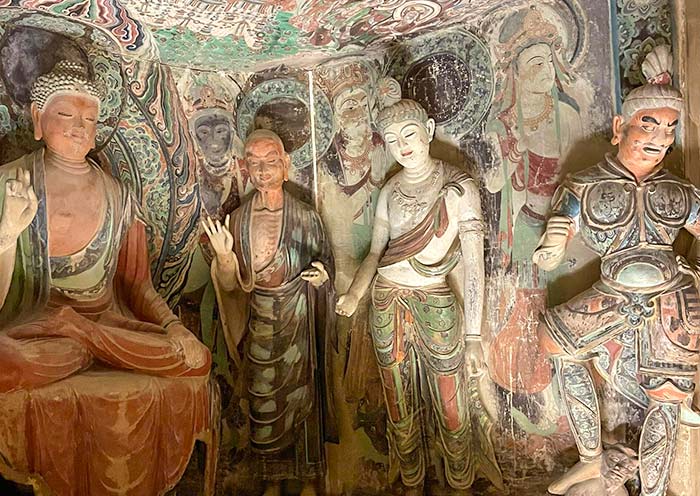
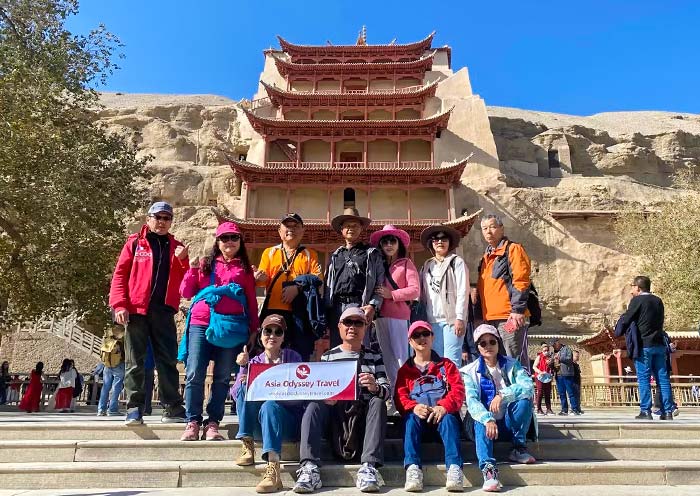
There's a saying in Chinese Buddhism: "一花一世界, 一叶一菩提" meaning you can see the whole world through a single beautiful petal of a flower. Visiting the best grottoes in China, the Mogao Caves, offers an experience just like that.
Through the Chinese Buddhist art pieces of the Mogao Caves, you will encounter memorable aesthetic delights and cultural insights into the religious, cultural, and historical heritages of China, especially those related to the treasures of mankind from the Ancient Silk Road, showcasing both spiritual and secular daily life throughout the centuries.
What makes Mogao Caves more worth visiting is you can combine various Dunhuang Attractions like Mingshan Mountain, Dunhuang Global Geo Park for a more fulfilling travel.
The Grottoes of Mogao, or the Mogao Caves(莫高窟) situated in Silk Road, Gansu Province, are a UNESCO World Heritage Site renowned for their extensive collection of Buddhist art. Founded in the 4th century AD, these Buddhist Caves were carved into the cliffs of Mingsha Mountain(鸣沙山) by devout Buddhist monks and pilgrims.
Over the centuries, the number and complexity of the Caves grew, reflecting the evolving artistic styles and religious practices of ancient China.
The Mogao Caves' location along the Silk Road made them a vital cultural hub, attracting artists, monks, and traders from across Eurasia. This exchange of ideas led to a unique blend of Chinese, Indian, and Central Asian artistic influences.
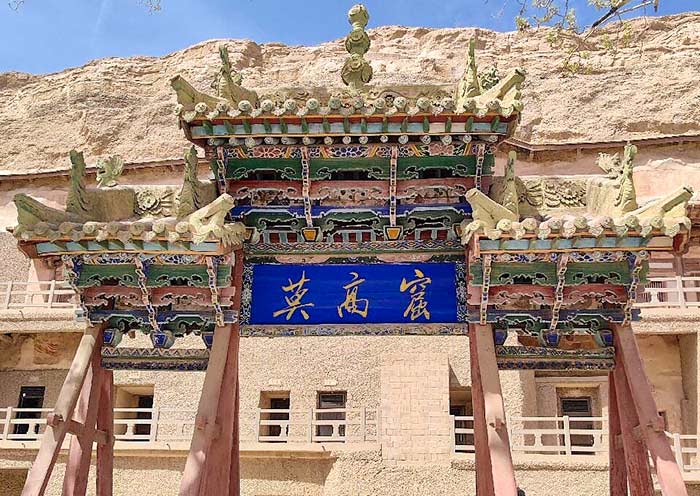

The Mogao Caves were once lost in the history, and rediscovered by a Taoist Monk in the year 1900. Currently, 492 Bhuddist Caves remain, housing over 2,000 sculptures and around 45,000 square meters of murals. These murals depict various Buddhist sutras, historical figures, and even scenes from daily life!
The Buddhist caves in China are never just about Buddhism, the Grottoes showcase life itself along the history.
Introducing the Dunhuang Manuscripts from Library Cave of the Mogao Grottoes, which contained over 50,000 manuscripts and relics, ledgers of merchants, logbooks of tradesmen, divorce paper, and kids' homework. (Yes, there were homework too. One find in another Grottoes in China shows a kid from 1,300 years ago whined about there being too much homework in his diary. It seems that struggling with homework has been a thing in Asia for centuries.)
All those marvelous finds from the Mogao Caves led to the development of a specific field of research called Tunhuangology or Dunhuangology(敦煌学). Its scope encompasses religion, literature, language, art, archaeology, technology, and architecture, with a particular emphasis on the discoveries made at the Mogao Caves.
And of course, academic values aside, as a Must-Visit Grottoes in China the Mogao Caves offers fun travel experiences with tourist-friendly amenities too. It is arguably one of the most developed attractions in China.
Travel Highlights of Mogao Caves
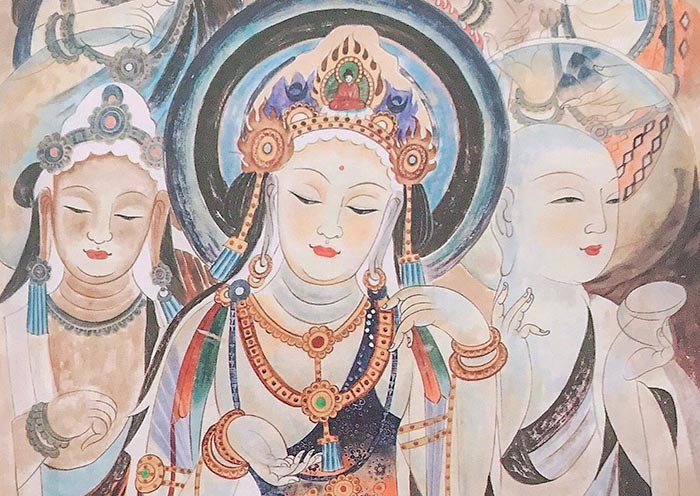
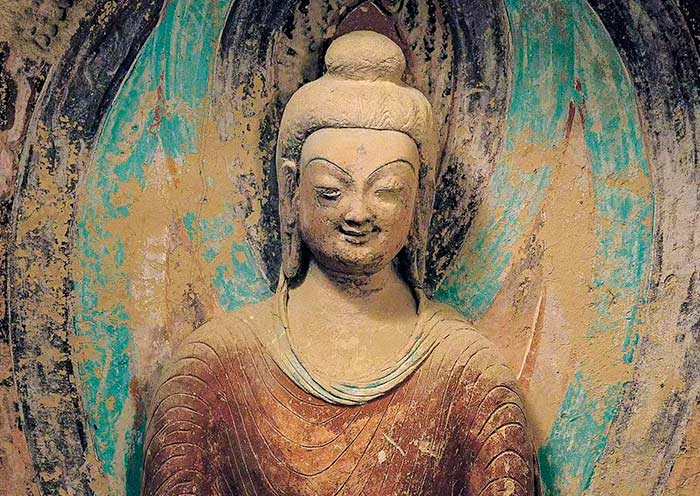
Cave 275: This cave is famous for its "Flying Apsaras(敦煌飞天)," a group of celestial maidens depicted in graceful poses.
Cave16/17: The library caves where the famous Mogao Manuscripts are kept.
Cave 45: This cave is considered one of the most exquisite in the Mogao Caves, featuring intricate murals depicting scenes from Buddhist mythology.
Cave 96: This cave is famous for its towering statues of Buddha and Bodhisattvas, which are among the largest and most impressive in the Mogao Caves.
Cave 171: This cave is known for its stunning murals depicting scenes from the life of Buddha. The paintings are characterized by their vibrant colors, realistic figures, and detailed landscapes.
Immersive Movies: Yes! There are immersive movies. You can watch fulldome movies that bring Flying Apsaras to life at Digital Centre of Mogao Caves!
Note: There are plenty more caves worth exploring in the meantime not all caves will be open to tourists all at once.
Do check with official channels to make sure or simply Contact your travel expert at Asia Odyssey Travel to plan your visit to Mogao Caves!
Where is Mogao Caves

Mogao Caves are located on the cliffs of Mingsha Mountain, about 25 km southeast of Silk Road.
How to Get to Mogao Caves
You can reach Dunhuang by flight or train from major cities like Lanzhou and Xi'an. From Dunhuang, a bus or taxi can take you to the caves in about 30 minutes.
How to Get to Dunhuang & Mogao Caves: By Air, Train & Road (2025 Guide)
Tips for Visiting Mogao Caves
Not all caves are accessible: The local authorities are very focused on preserving the relics in the Mogao Caves. Not all caves are available for tourists, some have seasonal opening times, some require extra entry fees, and others have shorter limited visiting hours.
Full-dome movies at Mogao Caves Digital Center: Mogao Caves Digital Centre is also worth visiting.
Help with the preservation: Follow your guide and their instructions at all times to help preserve one of the most valuable grottoes in human history!
Visit Yulin Grottoes: The Yulin Grottoes near the Mogao Grottoes are also worth visiting. Be sure to combine your visits to China's Buddhist Caves to maximize your trip. See details of Yulin Grottoes at item 9 of this guide.
Book in advance: For Mogao Caves it's never too early to book it. Book your tickets as early as you can!
Do it now: There has been discussion that the Mogao Caves will be closed for good once they finish constructing the replicas of the relics. By that time, even if you decide to visit the caves, you will only see replicas. The real artifacts will be kept in preservation chambers and not be available for tourists.
So visit the best Buddhist Caves in China while you can! Plan your China Trip with Asia Odyssey Travel, Contact us now!
2. Yungang Grottoes: Magnificent Buddha Statues, Unified Art Style with Chinese Localization
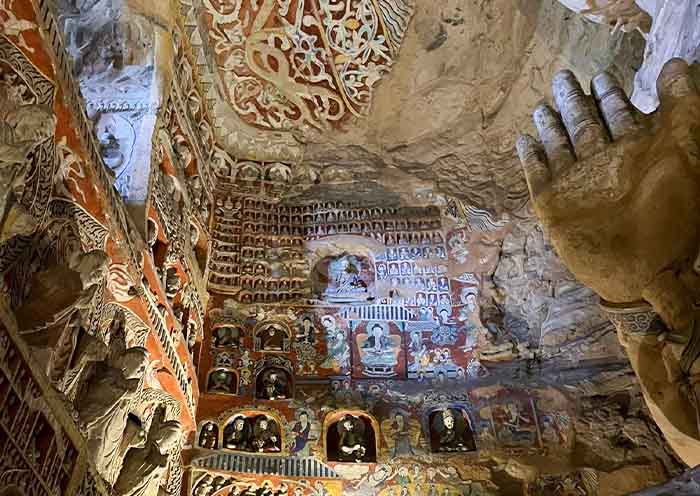
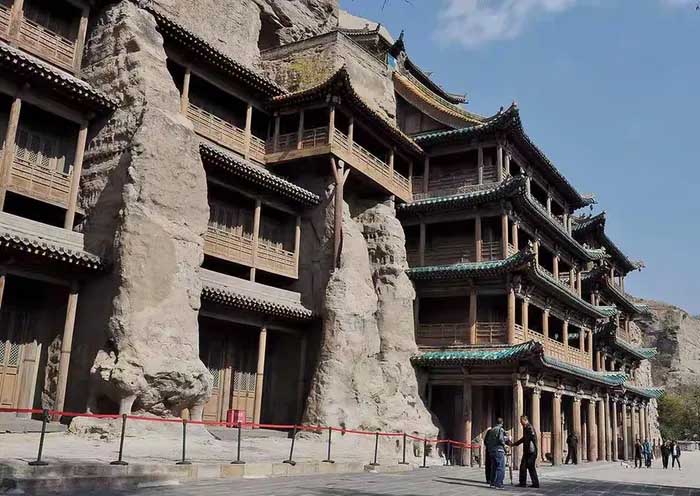
Unlike most other beautiful grottoes and Buddhist caves in China, which were built over centuries with various art styles and relics of varying significance, the Yungang Grottoes were constructed during a single dynasty, commissioned by emperors.
This means the artifacts and statues at Yungang Grottoes are grand, exquisite, and of a unified art style. It's like a single malt whisky or a SOE coffee among the Chinese Grottoes:pure, single-origin Buddhist art with Chinese localization - that's exactly why the Yungang Grottoes are one of the top four Chinese Buddhist caves!
The Yungang Grottoes, located in Datong, Shanxi Province, are another UNESCO World Heritage Site renowned for their collection of Buddhist art. The caves were carved into a sandstone cliff face during the Northern Wei(北魏) Dynasty (386-534 AD). The construction of the grottoes was sponsored by the Northern Wei emperors, who were devout Buddhists.
The Yungang Grottoes are especially famous for their towering statues of Buddha and Bodhisattvas, which are considered among the largest and most impressive Buddhist sculptures in all of China. These remarkable sculptures are characterized by their realistic features, flowing robes, and serene expressions, showcasing the exceptional artistry and craftsmanship of the ancient Chinese Buddhist sculptors.

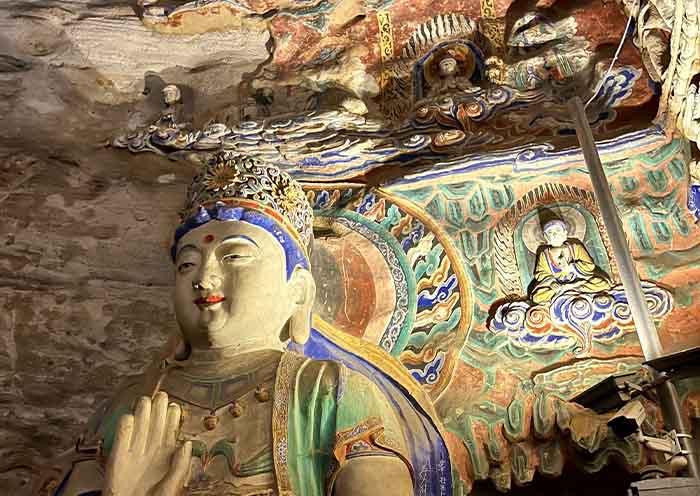
Just like the Mogao Caves, the Yungang Buddhist Caves serve as vital cultural hubs, attracting artists, monks, and travelers along the historic Silk Road networks. The diverse array of Buddhist art and architecture preserved within the Yungang Grottoes offer invaluable insights into the evolution of Chinese Buddhist artistic traditions during the influential Northern Wei period.
Highlights of Yungang Grottoes
Cave 16: This Buddhist Cave is considered the largest and most impressive in the Yungang Grottoes. It features a towering statue of Vairochana Buddha, which is over 40 meters/131 feet tall.
Cave 20: This Buddhist Cave is famous for its group of five standing Buddhas, which are arranged in a symmetrical composition. The Buddhas are surrounded by smaller figures of Bodhisattvas and disciples.
Cave 45: This Buddhist Cave is known for its intricate carvings and murals, which depict scenes from Buddhist mythology.

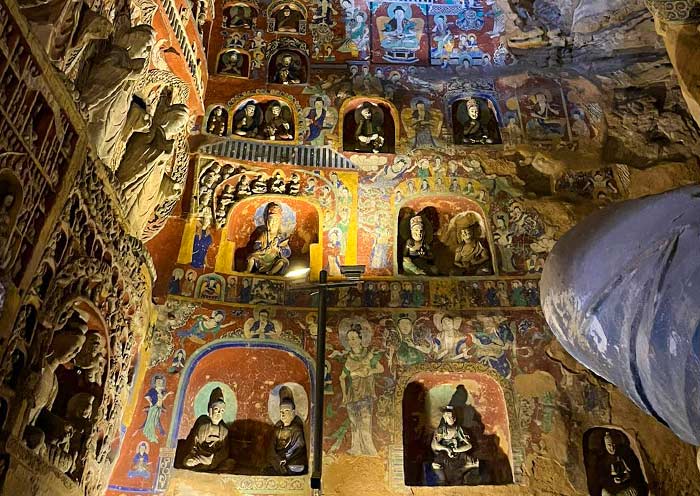
Cave 52: This Buddhist Cave is famous for its group of three seated Buddhas, which are arranged in a hierarchical composition. The central Buddha is larger and more prominent than the other two.
Note: There are plenty more caves worth exploring in the meantime not all caves will be open to tourists all at once.
Do check with official channels to make sure or simply Talk to your travel expert at Asia Odyssey Travel to plan your visit to Mogao Caves!
Where is Yungang Grottoes
The Yungang Grottoes are located 23 km West to Datong city, Shanxi Province, China.
How to Get to Yungang Grottoes
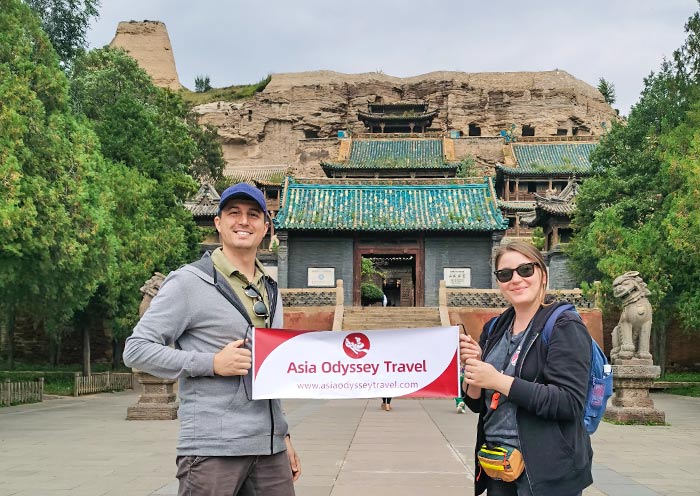

The nearest major airport is Datong Airport, which serves flights from several cities in China.From the airport, visitors can take a taxi or bus to the Yungang Grottoes.
Tips for Visiting Yungang Grottoes
Book in Advance: Visitors must purchase tickets in advance to enter the grottoes.
Exception for Photo: Unlike Mogao Caves, photography is allowed in some caves of Yungang Grottoes, but there are restrictions in certain areas. Visitors should check the rules before taking photos.
Visiting Routes Matter: The Buddhist Caves are dotted throughout the Grottoes complex, plan your visiting route can maximize your travel.
Talk with your travel expert at AOT to plan your visiting route for the Yungang Grottoes!Plan your China Trip with Asia Odyssey Travel, Contact us now!
3. Longmen Grottoes Largest Stone Carving Complex in China, Night Tour Available


The Longmen Grottoes, a renowned UNESCO World Heritage Site, are located in the Chinese province of Henan, near the city of Luoyang. These exquisite Buddhist Caves were carved into the cliffs of the Yi River during the Tang(唐朝) and Song(宋朝) dynasties, spanning the years 618-907 AD and 960-1279 AD respectively.
The construction of these remarkable Buddhist Grottoes was sponsored by the imperial court as well as wealthy individuals, showcasing the dedication and patronage towards this magnificent art form.
The Longmen Grottoes are celebrated for their towering statues of Buddha and Bodhisattvas, which are among the largest and most impressive in all of China. The sculptures within these Buddhist Caves range from the modest 1.9 cm (0.75 inches) to the grand and awe-inspiring 5.1 meters (16.7 feet) in height. These statues are characterized by their realistic features, flowing robes, and serene expressions, truly capturing the essence of Buddhist spirituality.
Highlights of Longmen Grottoes

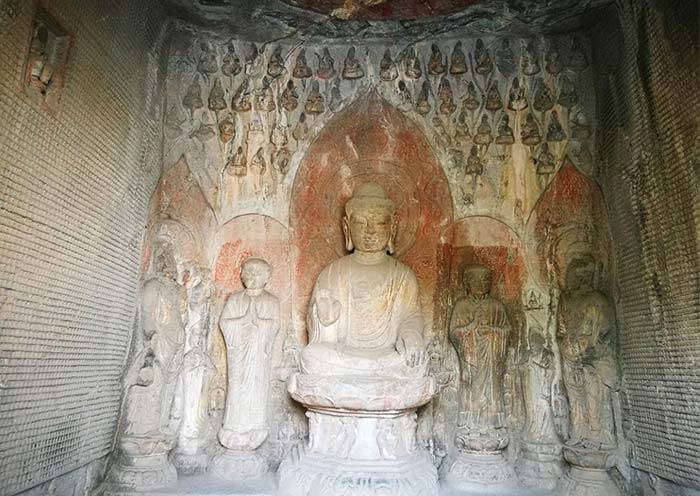
Fengxian Temple: This Buddhist Temple within the Longmen Grottoes is considered the most impressive, featuring a towering statue of Vairochana Buddha that stands over 17 meters tall.
Binhe Cave: This Buddhist Cave is famous for its group of three seated Buddhas, arranged in a hierarchical composition, with the central Buddha being larger and more prominent than the other two.
Guyang Cave: This Buddhist Cave is known for its intricate carvings and murals, which depict captivating scenes from Buddhist mythology.
Xiangshan Temple: This Buddhist Temple is famous for its group of five standing Buddhas, arranged in a symmetrical composition, surrounded by smaller figures of Bodhisattvas and disciples.
Night Tour: The Longmen Grottoes take on a whole different and sacred ambiance at night, as the Buddhist Caves scattered along the cliffs are illuminated, creating a mesmerizing experience for visitors to Longmen Grottoes.
Where is Longmen Grottoes
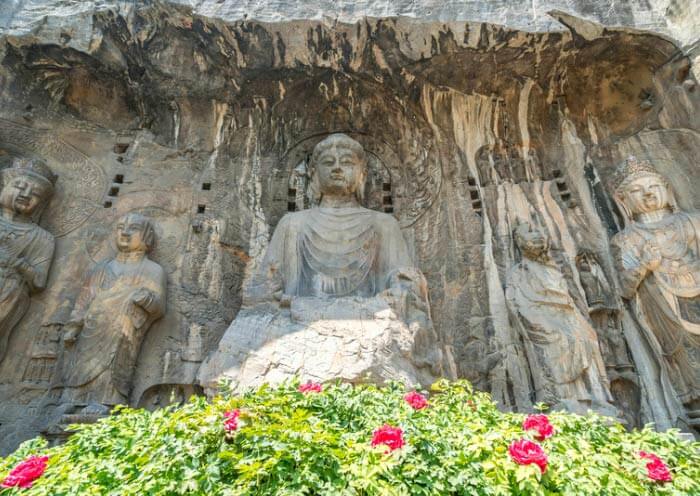
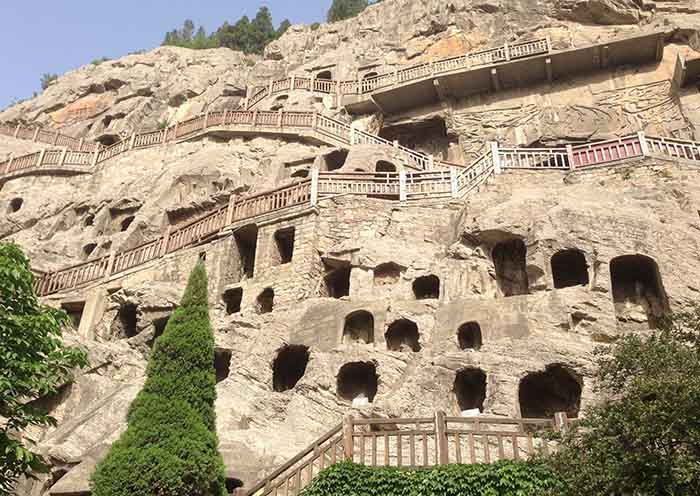
The Longmen Grottoes are located 12 kilometers south of Luoyang, Henan Province, along the banks of the Yi River.
How to Get to Longmen Grottoes
Local buses run frequently from Luoyang city to the grottoes.
Practical Tips for Visiting Longmen Grottoes
Accessibility: Many paths are carved into the hillside, so wear sturdy shoes and be prepared for some climbing.
Take Shuttels: The Longmen Grottoes complex is vast, do take shuttle bus if you would like to skip some walking.
Nearby Attractions: Don't miss the White Horse Temple, one of the oldest Buddhist temples in China, and the Luoyang Museum, home to a vast collection of cultural relics.
4. Maijishan Grottoes: See How Buddhist Art Evolve through Dynasties in China

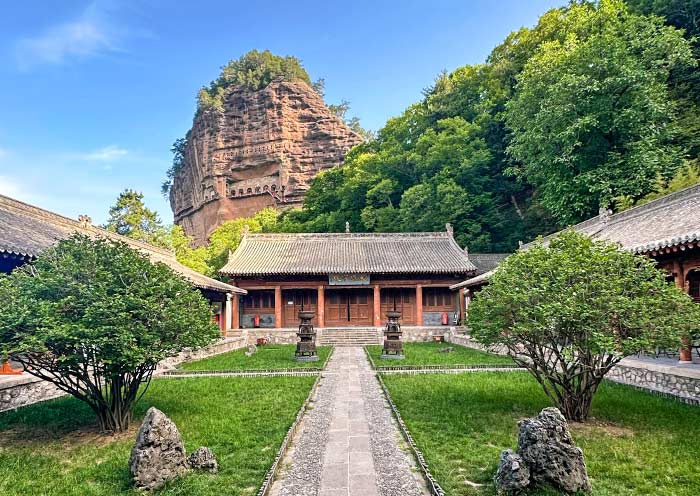
What makes the Maijishan Grottoes special is the long-lasting construction period. The construction of the Maijishan Grottoes, spanning from the Northern Wei to the Tang dynasties, covers a time span that includes the rise and fall of ten dynasties in China.
Thus, the Maijishan Grottoes can be considered a chronicle of how Buddhist art evolved in China. Built, decayed, destroyed in earthquakes, and rebuilt over and over, this process reflects the Buddhist concept of "成住坏空" (formation, existence, decay, and emptiness).
The Maijishan Grottoes, a renowned UNESCO World Heritage Site, are situated in the Chinese province of Gansu, within the city of Tianshui. These remarkable Buddhist Caves were carved into the cliffs of Mount Maiji over an impressive span of approximately 600 years, starting from the Northern Wei Dynasty (386-534 AD) and continuing through the Tang Dynasty (618-907 AD).
The construction of these magnificent Buddhist Grottoes was sponsored by the imperial court, wealthy individuals, and Buddhist monks, reflecting the widespread patronage and devotion towards this sacred artistic endeavor.
The most extensive period of construction for the Maijishan Grottoes occurred during the Tang Dynasty, when a significant number of these Buddhist Caves were added and expanded. This era was marked by a remarkable flourishing of Buddhist art and culture in China, and the Maijishan Grottoes became a prominent center of religious pilgrimage and artistic activity.
Highlights of Maijishan Grottoes
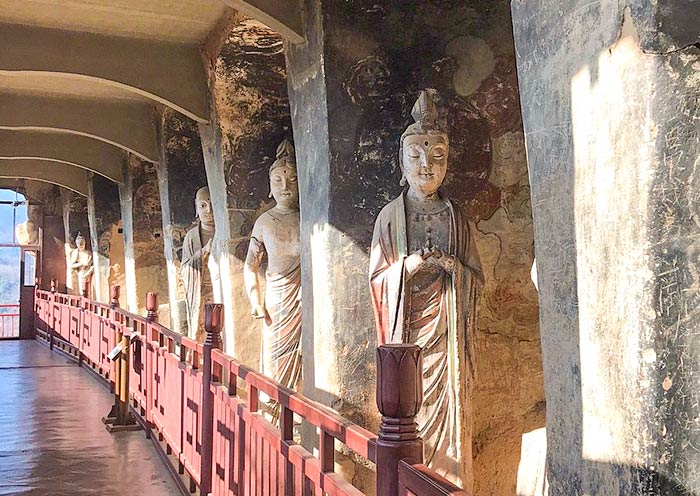
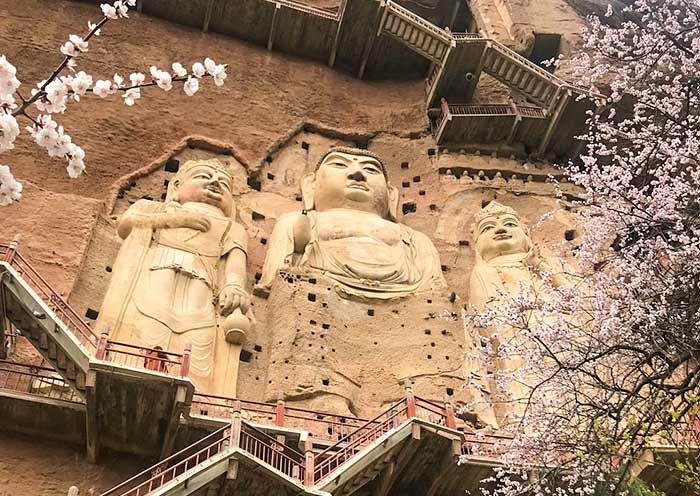
Cave 133: This cave is famous for its unique "clay sculpture" technique, which was used to create the figures of Buddha and Bodhisattva. The sculptures are intricately detailed and painted in vibrant colors.
Cave 143: This cave is considered the most impressive in the Maijishan Grottoes. It features a towering statue of Vairochana Buddha, which is over 15 meters tall.
Cave 42: This cave is famous for its group of five standing Buddhas, which are arranged in a symmetrical composition. The Buddhas are surrounded by smaller figures of Bodhisattvas and disciples.
Where is Maijishan Grottoes
Situated about 45 km southeast of Tianshui in Gansu Province.
How to Get to Maijishan Grottoes
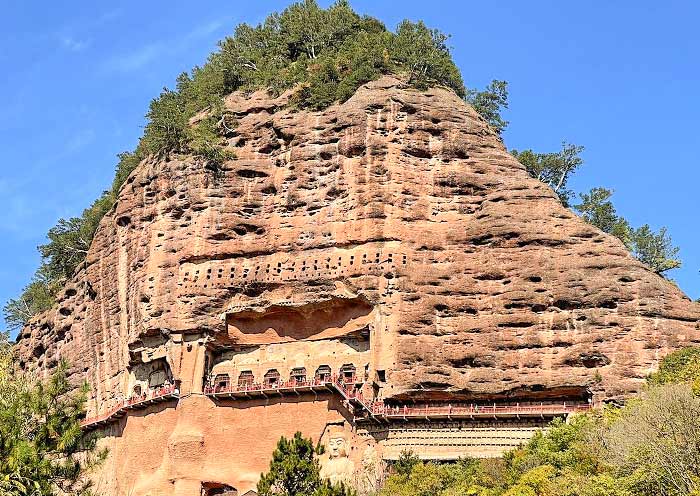
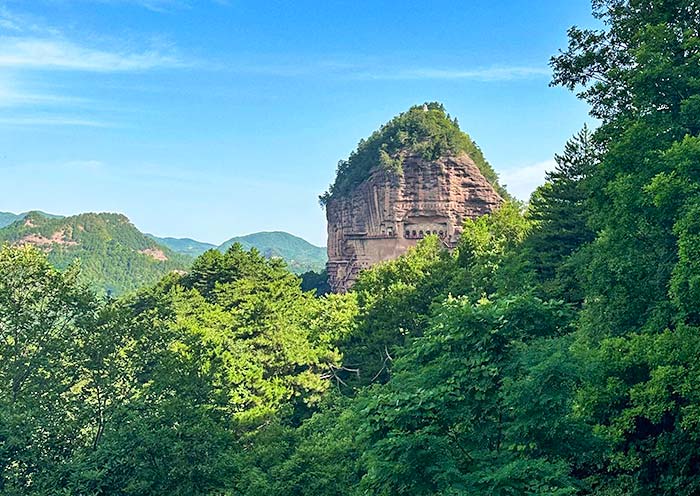
Tianshui can be reached by train from Xi'an or Lanzhou. From Tianshui, buses and taxis are available to reach the grottoes.
Tips for Visiting Maijishan Grottoes
Accessibility: The grottoes are built into steep cliffs, so be prepared for lots of stair climbing.
Extra fees for special caves: There are many special caves at the Maijishan Grottoes. They are all worth visiting while all would require an extra entry fee. If to visit them all a total cost of over 2,000 RMB. Choose with your special caves thoughtfully.
Talk with your Travel Expert at Asia Odyssey Travel to map out your visit to Maijishan Grottoes. Plan your China Trip with Asia Odyssey Travel, Contact us now!
5. Bingling Temple Grottoes: Speed Boat Ride to Encyclopedia of Chinese Grottoes


Bingling Temple Grottoes is famous for its diverse artworks, influenced by many cultures thanks to its location along the Silk Road.
The boat ride to the Bingling Grottoes offers stunning distant views of the Buddhist caves on the water, providing a unique travel experience that you probably won't find at other grottoes in China.
The Bingling Temple Grottoes, a UNESCO World Heritage Site, boast a rich history dating back to the Western Qin Dynasty (414-431 AD). This makes them one of the earliest dated grottoes in China, predating even the renowned Mogao Grottoes.
Located along the Silk Road, these grottoes have been influenced by various artistic styles, including Gandhara, Mathura, Kucha, and Central Plains Buddhist art. That's why the Bingling Temple Grottoes are regarded as the encyclopedia of Chinese grottoes as art pieces here reflect the remnants of many other grottoes in China.
Highlights of Bingling Temple Grottoes

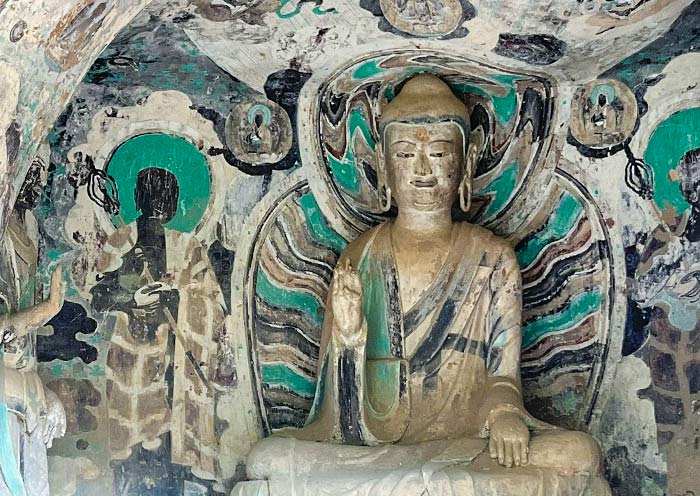
Seated Clay Maitreya Buddha Statue: This iconic 27-meter-tall statue, dating back to the Tang Dynasty, is a must-see. It ranks as the fifth largest Buddha statue in China and ninth globally.
Diverse Artistic Styles: The grottoes showcase a wide range of artistic styles, reflecting the cultural exchange along the Silk Road.
Extensive Collection: With over 183 alcoves, 694 stone carvings, 82 clay sculptures, and 900 square meters of murals, Bingling Temple offers a vast collection of Buddhist art.
Where is Bingling Temple Grottoes

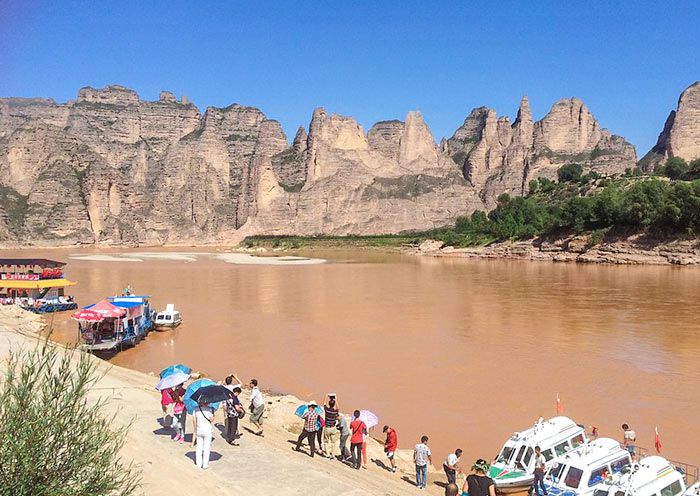
Bingling Temple is located on the bank of the Yellow River, near the Liujiaxia Dam in Gansu Province, China.
How to Get to Bingling Temple Grottoes
Bingling Temple is located at waterfront, can be reached by taking a high-speed train to Lanzhou and then a boat tour through the Liujiaxia Gorge.
Switching among Train, bus, speedboat to reach the Grottoes can be overwhelming, do consider a local tour with Asia Odyssey Travel can be the best option. Contact your travel expert to plan your smooth trip!
Tips for Visiting Bingling Temple Grottoes
Take a Boat Tour: The boat tour through Liujiaxia Gorge offers stunning scenery and a unique experience.
Time Allocation: Plan for approximately 1.5 hours to explore the grottoes.
6. Matisi Grottoes: Once a Confucian Lecture Hall, Now a Large Buddha Cave Complex in China
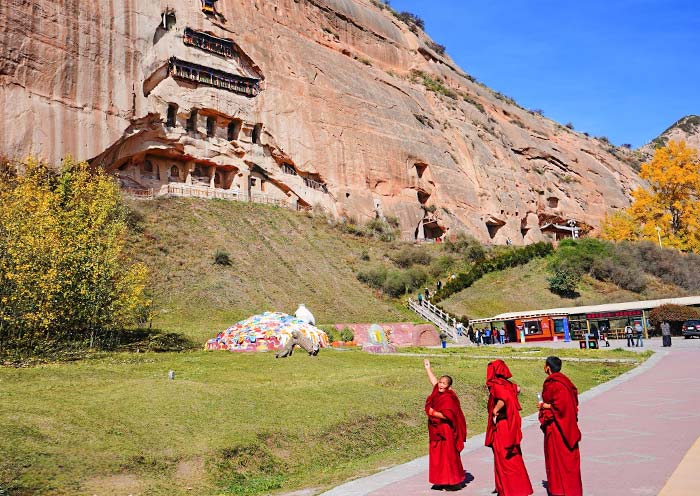
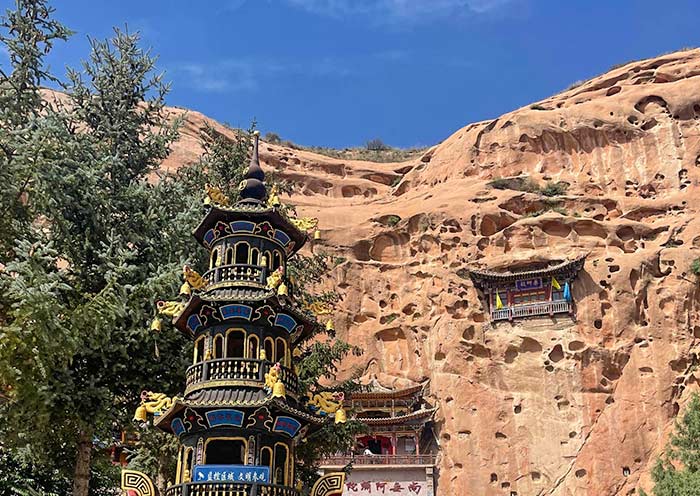
The Matisi Grottoes are among the Chinese Buddha Caves that feature a harmonious coexistence of cultural and religious diversity. The unique experience here, along with exquisite statues, includes the thrilling ladder climb to the Buddha Caves at Matisi Grottoes.
The Matisi Temple Grottoes, dating back over 1,600 years, are a significant cultural and religious site nestled in the Qilian Mountains. Originally carved by Guo Yu, a disciple of Confucian master Guo He, as classrooms, these grottoes played a crucial role in the development of the Hexi culture. Today, they serve as an important temple for the Gelug sect of Tibetan Buddhism.
Highlights of Matisi Grottoes
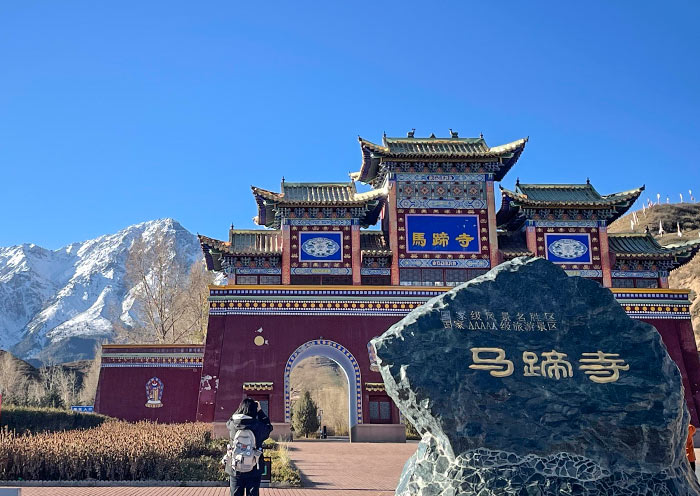
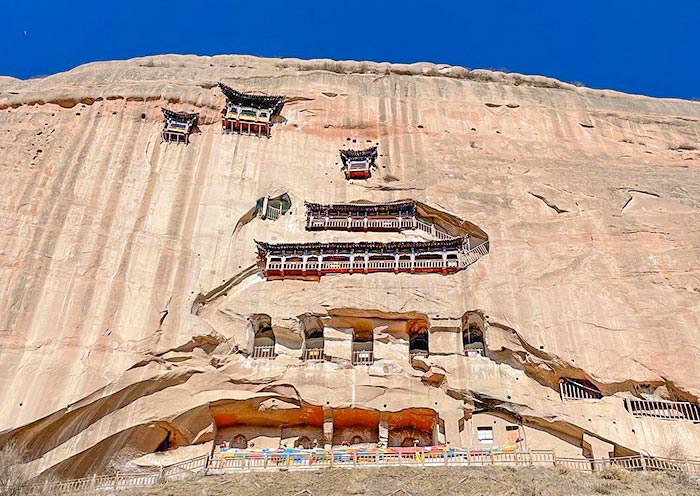
Ancient Buddhist Art: Discover over 100 Buddha statues, stupas, and 2,500 square meters of murals dating back to various dynasties.
Natural Beauty: Enjoy the stunning scenery of the Qilian Mountains, pine forests, and valleys.
Cultural Experience: Immerse yourself in the rich Tibetan Buddhist culture and history of the region.
Where is Matisi Temple
The Matisi Temple Grottoes are located approximately 65 kilometers south of Zhangye City, Gansu Province, near the Qilian Mountains.
How to Get to Matisi Temple
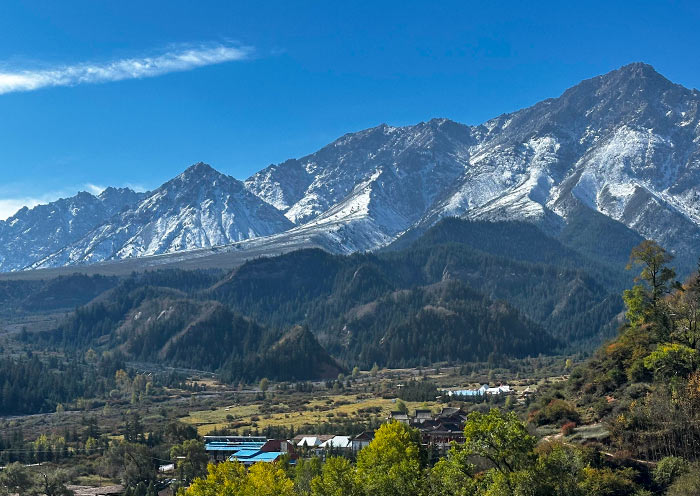
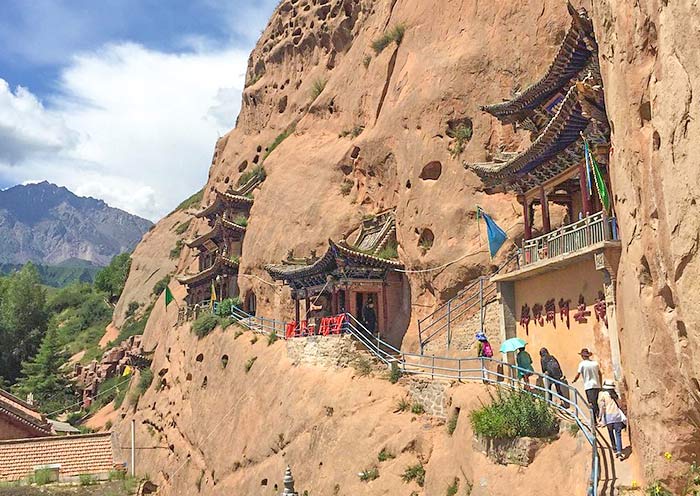
The nearest major airport is Zhangye Ganzhou Airport, which connects to several major cities in China. From Zhangye City, visitors can travel to the grottoes by hiring a car, taking a taxi.
Mati Temple is a must-visit Chinese Grottoes withou public transport access. For most international travellers joining a local tour group with Asia Odyssey Travel can be the best option. Contact your travel experts to plan your seamless journey!
Tips for Visiting Matisi Grottoes
Time Allocation: Plan for approximately two hours to explore the grottoes.
Hiking: Be prepared for some hiking as the grottoes are spread across a 20-kilometer area.
It's a bit high up: To visit the most intricate statues and master pieces at the Grottoes a climb on steep ladders to cliffs high up is a must. Make sure height won't be an issue for you.
Local Guides: Consider hiring a local guide to gain deeper insights into the history and cultural significance of the site.
7. Bezeklik Thousand Buddha Caves: Accessible Grottoes in Turpan, Xinjiang
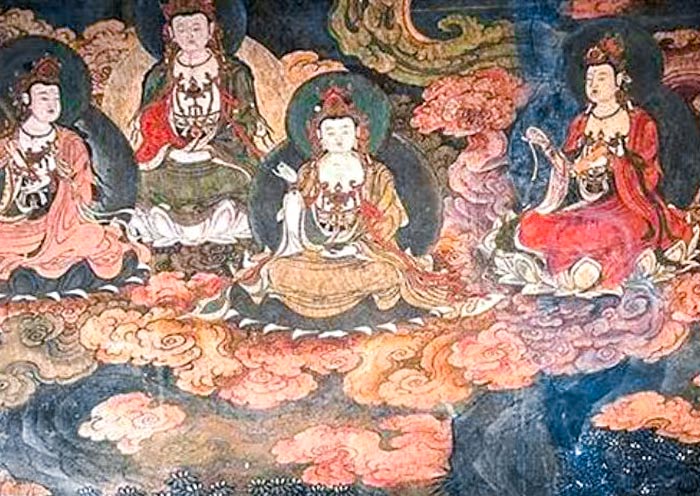
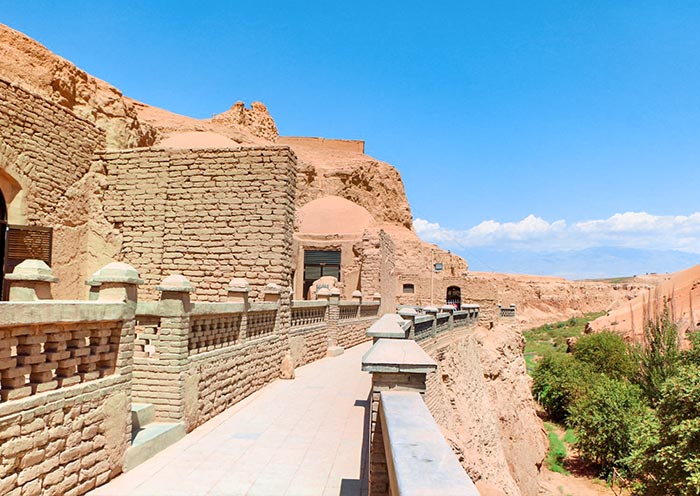
The Bezeklik Thousand Buddha Caves, situated in Turpan, Xinjiang, are a remarkable group of Buddhist caves carved into the cliffs of a ravine in China.
These grottoes were created between the 5th and 13th centuries, showcasing the significant influence of Central Asian Buddhism within Xinjiang.
Despite the damage and removal of many murals and statues during the 20th century(Yes, many great murals were brutally taken by westerners), the remaining artwork in these Buddhist caves offers valuable insight into the vibrant Buddhist culture that once thrived in Xinjiang.
The 77 accessible grottoes reveal murals that depict a rich tapestry of cultural influences, including Indian, Persian, and Chinese elements, reflecting the multicultural exchanges along the Silk Road in this unique region of China.
Highlights of Bezeklik Thousand Buddha Caves

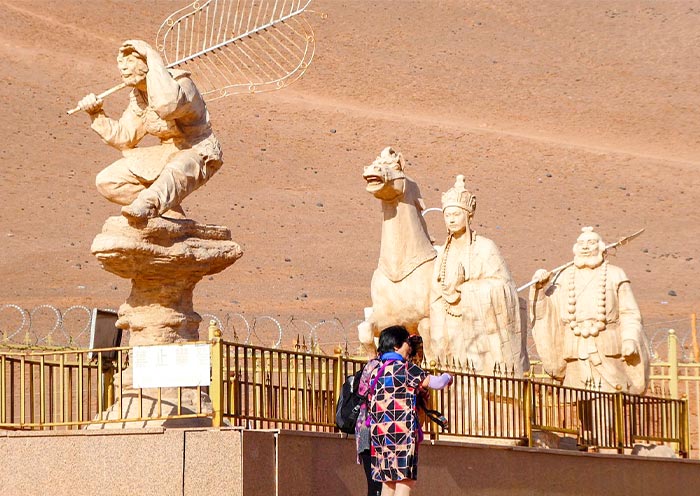
Murals: The caves are famous for their vibrant murals depicting scenes from the life of Buddha and Buddhist deities.
Kizil Style: The murals exhibit a unique "Kizil style" characterized by bright colors, elongated figures, and a strong sense of movement. The art style is origninated from Kizil Bhuddha Grottoes, which we will get to next.
Central Asian Influence: The art of the Bezeklik caves reflects the cultural exchange along the Silk Road, blending Chinese and Central Asian artistic traditions.
Where is Bezeklik Thousand Buddha Caves
The Bezeklik Thousand Buddha Caves are located in Turpan, Xinjiang Uyghur Autonomous Region.
How to Get to Bezeklik Thousand Buddha Caves
The ideal major airport is Urumqi Diwopu International Airport. With other attractions like Flaming Mountains, Grape Valley, Karez System located near the Caves, it is more efficient to join a tour with Asia Odyssey Travel. This way you can visit more attractions in one go with ease. Talk to your travel expert to make the most of your spiritual journey!
Tips for Visiting Bezeklik Thousand Buddha Caves
Remote Location: The Bezeklik Thousand Buddha Caves are located near Turpan city, in close proximity to other attractions like the Flaming Mountains, Grape Valley, and the Karez System.
However, there is no frequent public transportation due to their remote location, so join a tour with AOT to enjoy the best-planned visiting routes for the Bezeklik Thousand Buddha Caves and other Xinjiang Attractions.
Fragile Murals: To protect the delicate murals, photography is restricted in some areas.
8. Kezil Thousand-Buddha Grottoes: Might be The Earliest Buddha Caves in China

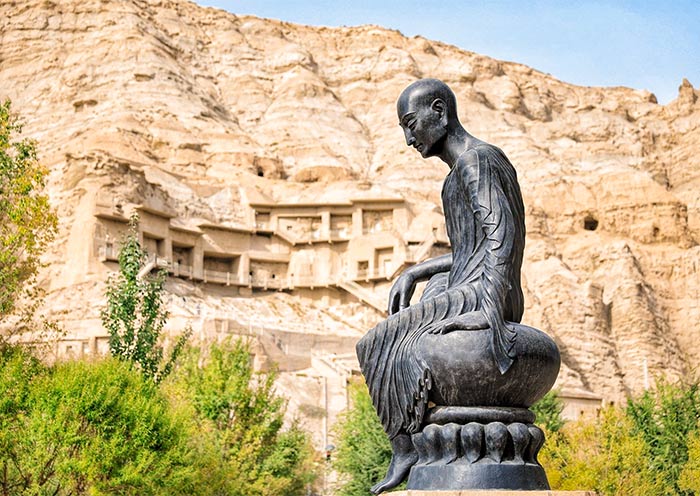
The Kizil Buddha Caves are considered one of the earliest significant Buddhist cave complexes in China. Unlike other grottoes in China, the Kizil Grottoes preserve more original murals, although some areas have been damaged over time.
Located at the westernmost point of the Silk Road, this region was one of the first to be influenced by distinct Indo-Iranian and Central Asian artistic styles.
These caves were carved into the cliffs of a ravine from the 4th to the 13th centuries. The Kizil Caves are renowned for their early examples of Buddhist art in China.
Highlights of Kezil Thousand-Buddha Grottoes
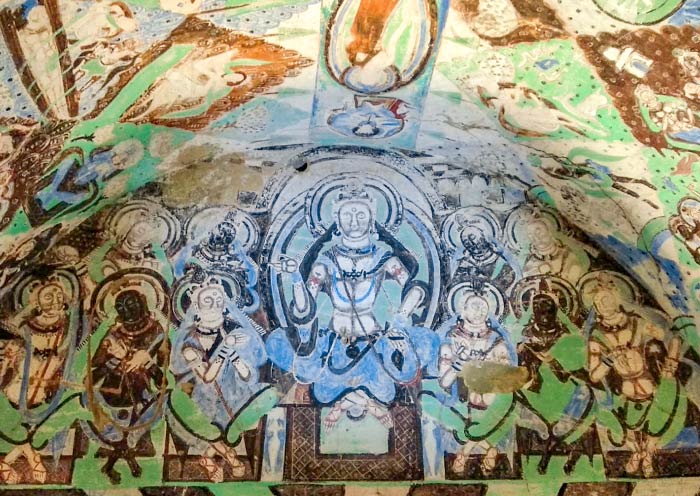

Early Buddhist Art: The caves contain some of the earliest examples of Buddhist art in China, dating back to the 4th century.
Kizil Style: Similar to the Bezeklik caves, the Kizil caves exhibit a unique "Kizil style" characterized by bright colors, elongated figures, and a strong sense of movement.
Central Asian Influence: The art of the Kizil caves reflects the cultural exchange along the Silk Road, blending Chinese and Central Asian artistic traditions.
Location and How to Get to Kezil Thousand-Buddha Grottoes
On the north bank of the Muza Ti River, 7 kilometers (approximately 4.3 miles) southeast of Kizil Township, Baicheng County, Aksu Prefecture.
You would need to take train to Kuqa first and then drive to Kizil, which would take 1.5 to 2 hours to get there.
Being one of the most remote Buddha Caves joining a tour to get there is essential for a less demanding trip. Contact your travel expert atAsia Odyssey Travel. Map out your trip hassle free!
Tips for visiting Kezil Thousand-Buddha Grottoes
The Kezil Thousand-Buddha Grottoes are among the most remote Buddha Caves in Xinjiang, making it more challenging to reach them. Visitors often opt to charter a vehicle to get to the caves, as public transportation can be a hassle, if it's available at all, from Kuqa to Kezil.
How to Plan a Road Trip in Xinjiang? (2025 Routes & Maps)
If you have specific interests in visiting some of the more authentic and better-preserved Buddha caves, navigating via public transportation can be difficult. Joining a tour group or having Asia Odyssey Travel's Travel Expert craft a Xinjiang Road Trip tour is the best option to visit these fascinating grottoes.
9. Yulin Grottoes: Lesser Known, Better Preserved Buddha Caves Near Mogao
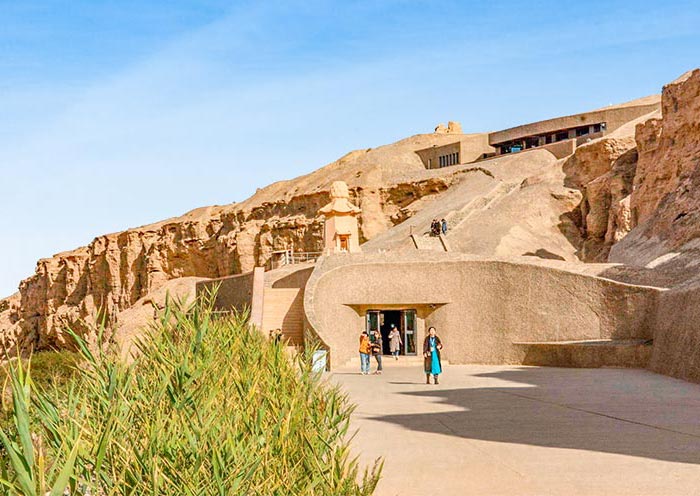

Of course, the Mogao Caves would undeniably rank at the top of your Chinese Grottoes list. However, few know that the Yulin Grottoes, located near the Mogao Caves, are equally worth exploring. Comparing to the Mogao Caves the Yulin Grottoes boast some of the best-preserved art pieces, are less crowded, and have fewer restrictions in terms of visiting length and flexibility.
For an in-depth Buddha Caves exploration or in case Mogao Caves tickets were sold out Yulin Grottoes would be the best attractions to visit on your Buddha caves tour.
The Yulin Grottoes, located in Guazhou County, Gansu Province, are a lesser-known yet significant site of Buddhist art, situated close to the more famous Mogao Caves.
Carved during the Northern Wei Dynasty (386-534 AD), these grottoes were part of a wider network of Buddhist sanctuaries along the Silk Road. They served as spiritual refuges for monks and pilgrims, reflecting the artistic styles of the time.
Highlights of Yulin Grottoes
The Chinese Blend of Buddhist Artwork: Cave 3 is a must-visit at Yulin Grottoes. You will have the chance to see the most balanced and finely tuned blend of exquisite Chinese painting style (山水画) with influences from India and Central Asia, highlighted by the murals depicting Manjushri and Samantabhadra.
The Earliest Depiction of Wukong and Tang Sanzang: Also in Cave 3 of the Yulin Grottoes, a mural vividly brings the epic Journey to the West to life, showing the Monkey King, Wukong, and his master, Tang Sanzang, on their journey. This is, so far, the earliest artwork found depicting Journey to the West, created 300 years before the novel itself.
So it is safe to say that the Yulin Grottoes have definitely been a visual inspiration for the video game Black Myth: Wukong.
Where is Yulin Grottoes
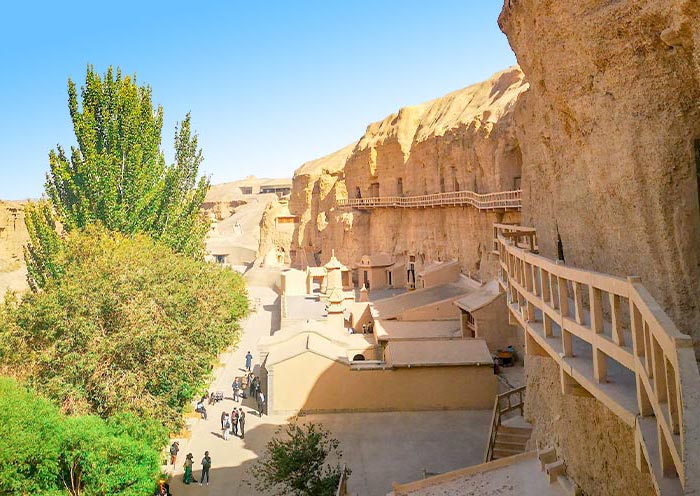

The Yulin Grottoes are located about 80 kilometers from Dunhuang, making them an easy addition to a visit to the Mogao Caves.
How to Get to Yulin Grottoes
To reach the Yulin Grottoes, you can take a taxi or join a local tour from Dunhuang or from Mogao Caves. The journey offers scenic views of the surrounding desert landscape, making it an enjoyable trip. Contact your travel expert at Asia Odyssey Travel. We have you covered for everything on the trip!
Tips for Visiting Yulin Grottoes
As part of the Dunhuang Grottoes, the Yulin Grottoes are located near the Mogao Caves, but reaching them requires a bit of a journey, as there is no public transport available.
However, the journey is not only possible but also enjoyable with transportation arranged by AOT's Ganus Tour. Traveling from the Mogao Caves to the Yulin Grottoes, you'll see camels roaming freely in the desert along the way, along with several interesting add-on destinations for quick stops!
Talk with your travel expert at Travel Expert to map out your visit to Maijishan Grottoes. Plan your Gansu Trip with Asia Odyssey Travel , Contact us now!
10. Dazu Rock Carvings: Stone Carvings of Three Religions at One Cave Complex
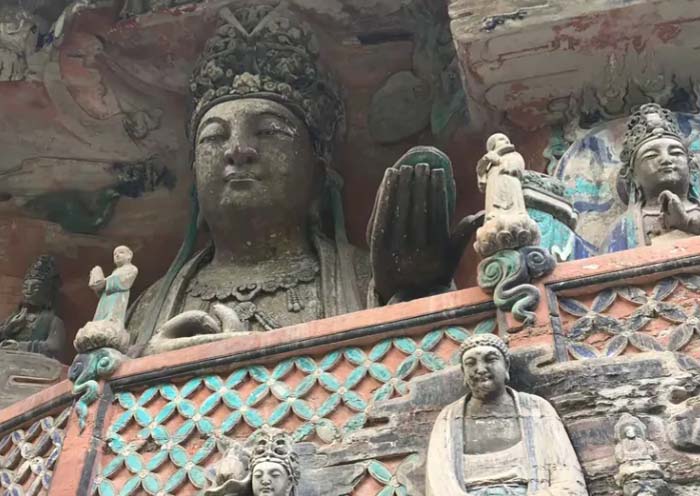
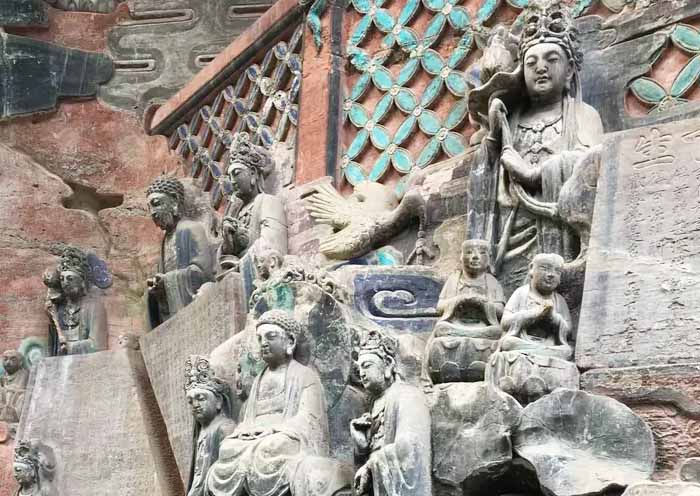
Unlike most Buddha Caves, which are located in the central or Northwest China, the Dazu Rock Carvings are situated in Chongqing, a magical city in southwestern China, with many fun and modern travel destinations nearby, such as the Yangtze River, the Panda Base in Chengdu, and great options for China Food Tour with a spicy kick.
If you are more interested in exploring the fun side of China while including one of the Chinese Buddha Caves in your trip, the Dazu Rock Carvings at the Temple Cave can be your top choice.
Recognized as a UNESCO World Heritage Site, these carvings represent a fusion of Buddhist, Taoist, and Confucian ideals, illustrating the spiritual and cultural landscape of the time. The carvings reflect the craftsmanship and religious devotion of the artists who created them.
Interestingly, the Dazu Rock Carvings showcase more than just Buddhist artwork that you would see at other Buddha Caves in China; they display a coexistence of both Buddhist and Taoist statues.
To many's surprise, it is perfectly acceptable to practice Buddhism, Taoism, and Confucianism simultaneously. There's even a special term for it: "儒释道三家." Naturally, you will see statues with intricate details representing all three religions at the Dazu Rock Carvings.
Highlights of Dazu Stone Carvings

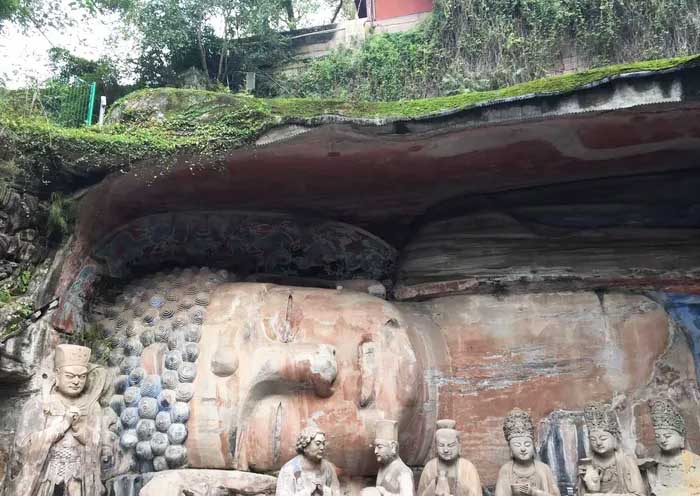
Baoding Mountain: This area features intricate reliefs and towering figures, including the impressive 31-meter-long reclining Buddha, which is a testament to the scale and detail of the carvings.
The Great Buddha of Nanshan: Another significant figure within the carvings, this massive statue embodies the artistic skill and devotion of the period.
Cultural Fusion: The carvings are unique for their blend of Buddhist, Taoist, and Confucian elements, reflecting the diverse religious practices of the time.
Shooting Site of Black Myth, Wukong: Not exactly a shooting site since Black Myth is a video game, but if you are a gamer, you will definitely recognize the exact virtual recreation of this Buddha Caves complex from the game, Black Myth, Wukong.
Where is Dazu Rock Carvings and How to Get There
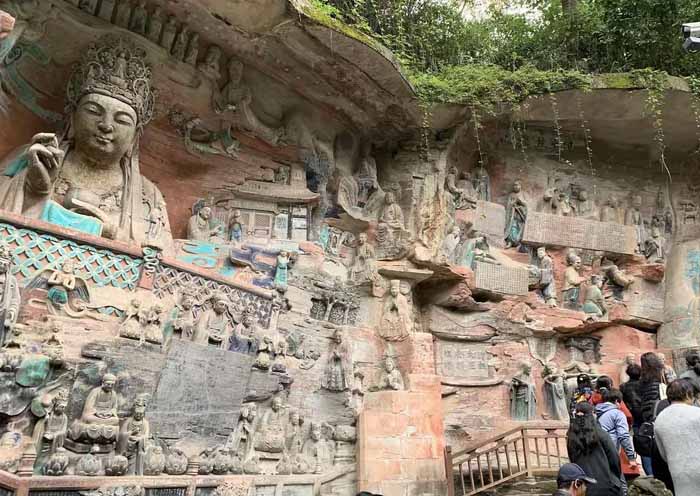
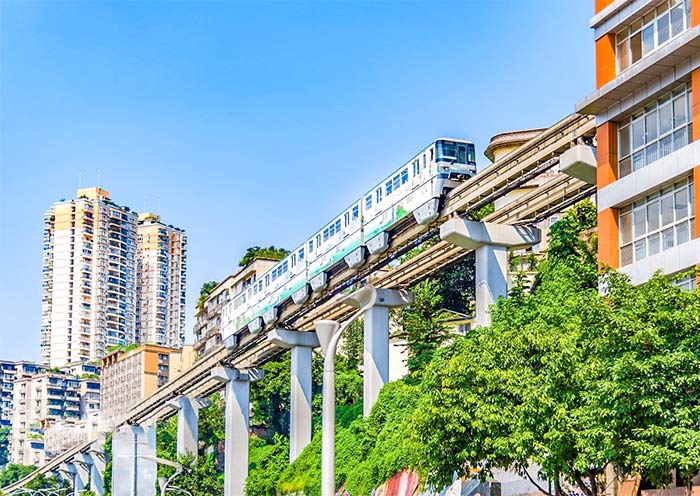
The Dazu Rock Carvings are located about 100 km from downtown Chongqing.
How to Getto Get to Dazu Rock Carvings
The Dazu Carving Caves are accessible for visitors looking to explore with Bus access, and it would be a bit of long-haul trip. Choose a tour with Asia Odyssey Travel to explore the magical Chongqing. Travel can be much easier talk to your travel expert now!Tips for Visiting Dazu Rock Carvings
Time Allocation for Movies: There's a movie theater at the attraction site that shows films as an introduction to the cultural background. Consider skipping the movie and finding a documentary online before your visit to save some time.
On-site Interpreter for More Insights: The Dazu Rock Carvings reflect influences from multiple religions, so a more detailed introduction from the on-site guide would be valuable for gaining an in-depth understanding of the enchanting carvings.
Insider Tips for Visiting Chinese Grottoes
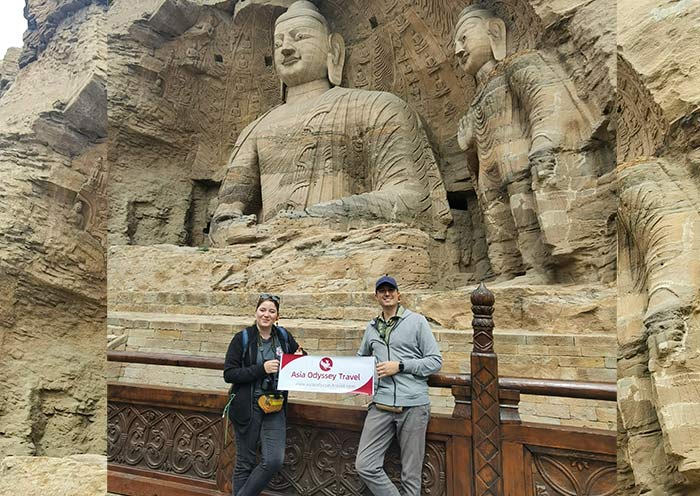
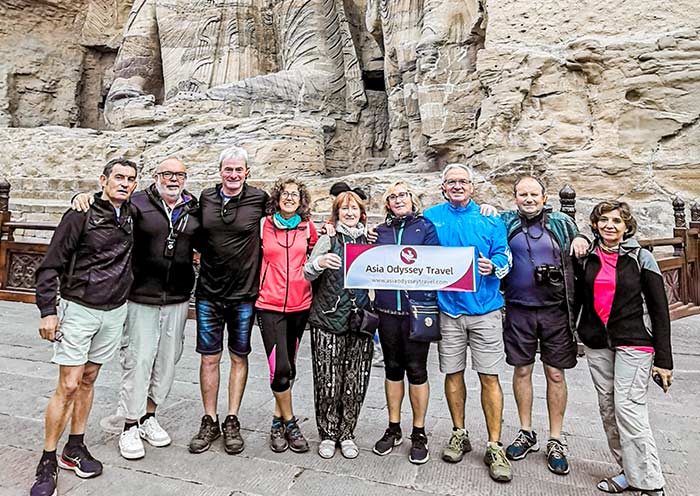
Plan Ahead: Research the specific grottoes you want to visit, including opening hours, ticket prices, and guided tour options. Some special Buddhist caves may require advanced reservations, and are not open year-round.
Route Planning: Some Chinese Grottoes Complex are vast and require more time to explore. Plan your route carefully to maximize your visit.
Dress Appropriately: Wear comfortable shoes for walking and dress modestly, as these sites often have cultural significance.
Visit During Off-Peak Times To avoid crowds, visit early in the morning or late in the afternoon. Consider going during the low season (late autumn to early spring) for fewer tourists.
Check Fees: Be aware of entrance fees, which can vary by site. Some special Buddhist Caves at the Grottoes Complex may have additional fees for special cave access or guided tours.
Respect the Sites: Follow rules regarding photography and touching the artworks. Always be mindful of preserving the integrity of these historical sites.
Explore Surroundings: Take time to explore the natural beauty and other nearby attractions for a more comprehensive experience.
Check Accessibility: Some grottoes, like Matisi Grottoes, may have steep paths or stairs; check accessibility options if you have mobility concerns.
Hire a Guide: Consider hiring a local guide for insights into the history and significance of the grottoes. This can enhance your experience significantly.
Planing your China Trip to visit the Chinese Buddhist Grottoes? Check out your How to guide:
Considering most of the Best Buddhist Caves in China are located along the Silk Road it would be a more interest focused travel to plan a China Silk Road Tour to visit these enchanting Buddhist Caves. Check your how to plan guide:>
How to Plan a China Silk Road Trip: 10 Easy Steps (2025 Guide)
Travel with Asia Odyssey Travel, Cultural & Spiritual Tours with Buddha Caves

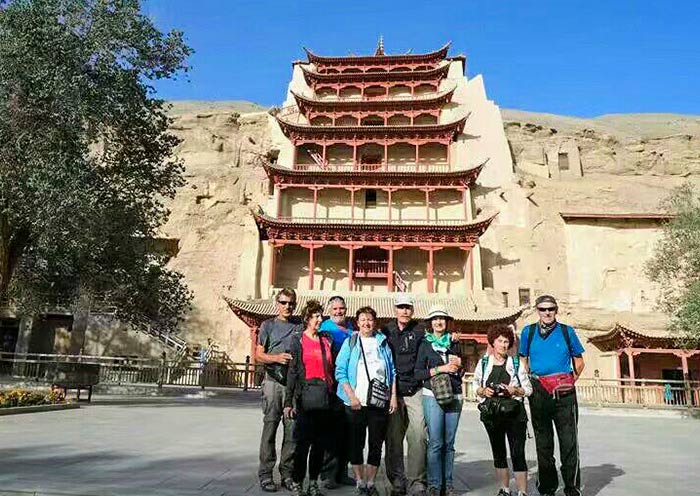
Are you seeking a spiritual path? Or do you just simply love admiring the exquisite Chinese arts from ancient times, the grottoes in China are a must-visit and worth revisiting time after time!
Many of China's Buddha Caves are nestled in serene, remote locations. And to fully appreciate these Grottoes in China, a bit of historical context can be extremely helpful.
That's why our China Tours and China Silk Road Tours are the best choice for visiting the famous grottoes in China. With seamless logistics planned out for you and an insightful local guide leading the way, your visit to the Chinese Buddha Caves will be an inspiring, educational, and spiritual journey!
Asia Odyssey Travel: Your Best Guide to Visit Grottoes in China
- Genuine Service: Not just an agency—we are your travel companions.
- Exclusive Access: Secure your tickets and accommodations even in high season.
- Authentic Experience: Best local guides with cultural insights.
- Travel Made Easy: Flights, hotels, activities—all taken care of!
- Extend Your Trip: Expert travel consultant to plan your trip with more destiantions in China
- 24/7 Support: Always on-line for your peace of mind
Asia Odyssey Travel, leading your China Adventure Since 2010. Our Travel Experts are always happy to help you map out your Chinese Buddhist Caves Itinerary. Let's talk!

